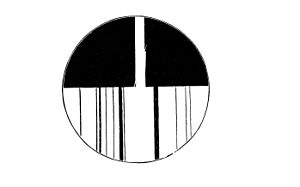duction of a set of standard colored disks with known constants, which can afterward be combined with each other, as well as with standard black or white disks, so as to generate at will, with ease and certainty, an immense number of tints whose constants will be known. If we make a record of the constants involved in such experiments, we can afterward reproduce the tints just as they originally were, or alter them to any desirable extent. To carry out the letter of this it will of course be necessary to view the standard disks under similar illuminations at different times, a point which can be secured with the

Fig. 6.—Eye-Piece for isolating the Tints of the Spectrum.
aid of the photometer above referred to. The standard disks can also be used for building up a set of standard charts, containing a vast variety of tints of known composition, arranged methodically with regard to purity, luminosity, and tone. These matters will be considered at some length in a separate chapter, and are now only hinted at as a justification for the trouble we have been at in defining the constants of color.
There is another point to be touched on in this connection. One of the most noticeable things about colors is their difference in intensity. Colors are intense when they excel both in purity and brightness; for it is quite evident that, however pure the colored light may be, it still will produce very little effect on the eye if its total quantity be small; and, on the other hand, it is plain that its action on the same organ will not be considerable if it is diluted with much white light. Purity and brightness, or luminosity, are, then, the factors on which intensity depends. We shall see hereafter that this is strictly true only within certain limits, and that an inordinate increase of luminosity is attended with a loss of intensity of hue.
Having defined the three constants of color, it will be interesting to inquire into the sensitiveness of the eye in these directions. This subject has lately been studied with care by Aubert, who made an extensive set of observations with the aid of colored disks.[1] It was
- ↑ Aubert, "Physiologie der Netzhaut," Breslau, 1865.
